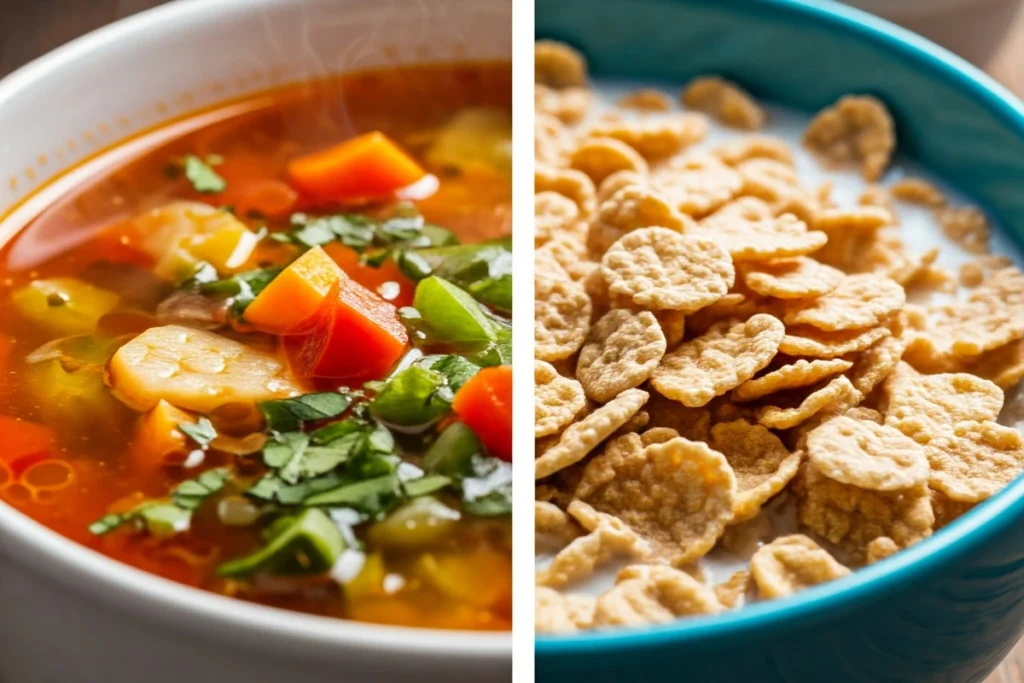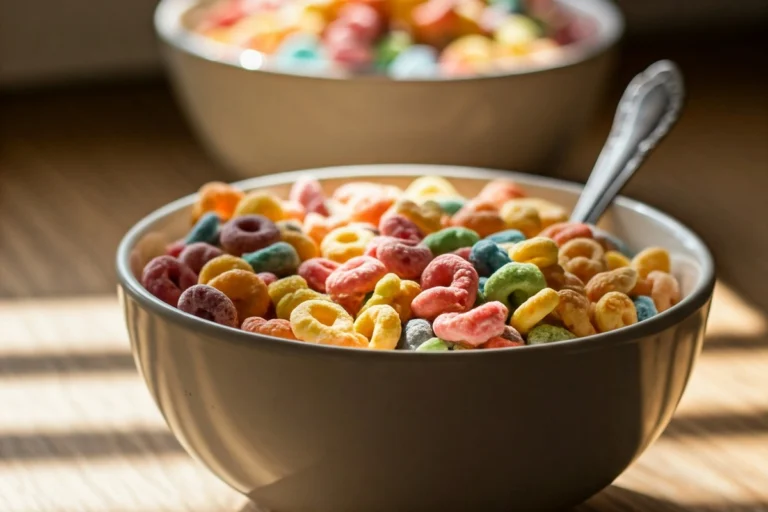Introduction
Ever found yourself pondering over a seemingly absurd yet oddly compelling question: is cereal a soup? Believe it or not, this debate has sparked countless online discussions and even led food enthusiasts to dissect culinary definitions. While it might seem like just a humorous internet argument, the debate uncovers fascinating insights into how we categorize food, interpret cultural norms, and understand culinary boundaries.
In this article, we’ll delve into the origins and definitions of soup and cereal, explore their similarities and differences, and consider what experts, food lovers, and science have to say. By the end, you might just have a fresh perspective—or at least a new favorite argument for brunch conversations!
Understanding the Definition of Soup
What Qualifies as a Soup?
Soup is one of those universally loved dishes that transcends cultures, yet its definition remains surprisingly tricky. Traditionally, soup is described as a liquid food prepared by boiling meat, vegetables, or grains in water, broth, or stock. From creamy tomato bisque to hearty chicken noodle, soups often feature cooked ingredients that meld together to create a flavorful dish.
But here’s the kicker: not all soups are hot! Cold soups like gazpacho and vichyssoise challenge the notion that warmth is a prerequisite. These examples show that soups can vary widely in texture, temperature, and ingredients, which complicates the question of whether cereal could fit the category.
Exploring Culinary Definitions
Culinary experts have weighed in on what makes a soup, with definitions often leaning on two key elements: the cooking process and the integration of ingredients. According to the Merriam-Webster dictionary, soup is typically made with a stock base, often containing meat, fish, or vegetables.
Interestingly, the inclusion of grains like barley or rice in soups, such as chicken and rice soup, creates a parallel with cereal. However, a critical distinction lies in preparation—cereal is not cooked together with its liquid base but rather assembled on the spot. Does this make cereal a standalone dish, or could it still squeeze into the soup category? The debate rages on.
What Is Cereal?
The Origins of Cereal
Cereal has long been a staple of breakfast tables worldwide, but its story begins in the 19th century as a health-focused innovation. Early pioneers like John Harvey Kellogg and Charles Post introduced ready-to-eat cereals, aiming to provide a convenient, nutritious start to the day. Over time, cereal evolved from simple whole grains to sugar-laden treats beloved by kids and adults alike.
Its essence, however, has remained the same: grains as the star ingredient. Whether oats, corn, wheat, or rice, the grain defines cereal’s identity.
Cereal’s Core Components
At its simplest, cereal consists of processed grains, often sweetened or flavored, served with a liquid—typically milk. This combination creates the hallmark crunchy-then-soft texture adored by many. Interestingly, some variations, like granola, can be consumed dry, suggesting that milk isn’t an absolute requirement.
But here’s where the question of “is cereal a soup” arises. Soup traditionally involves ingredients immersed in a liquid, a description that technically applies to cereal. Could milk in cereal be the equivalent of broth in soup? Not so fast—temperature, preparation, and cultural classification all come into play, as we’ll see in the next section.
Explore creative breakfast options like Tater Tot Breakfast Bowl to compare with cereal’s versatility.
The Milk Factor – Soup or Not?
The Role of Liquid in Soup
Liquid is a defining feature of soup, acting as the medium that combines and cooks its ingredients. Traditionally, this liquid is stock, broth, or water enriched with seasonings, providing depth of flavor. Milk, though less common, is sometimes used, especially in creamy soups like chowder or bisque.
Does cereal’s milk qualify as a soup base? Not exactly. Milk in cereal is uncooked and serves more as an accompaniment than a unifying element. While both are liquid mediums, their purposes differ fundamentally.
Is Milk Enough to Classify Cereal as Soup?
For cereal to be considered a soup, milk would need to play a more transformative role, akin to how broth brings together the ingredients in minestrone or ramen. However, cereal’s preparation is starkly different—grains are pre-processed and served with cold milk, often in seconds.
Adding to this, most soups involve a cooking process, where ingredients simmer together to meld flavors. This key step is absent in cereal, leaving it as more of a constructed dish than a cohesive culinary entity.
So, is cereal a soup? The case against it builds. Still, this breakfast favorite blurs enough lines to keep the debate alive in kitchens and forums everywhere.
For more on combining unexpected ingredients, check out this guide on unique casseroles.
Examining Similarities and Differences
Cereal vs. Soups: Texture and Consistency
At first glance, the texture of cereal in milk can seem similar to some soups. Think of chicken and rice soup or even creamy chowders—these dishes feature chunks of solid ingredients suspended in a liquid base. Similarly, cereal combines crunchy grains with milk, creating a dynamic mouthfeel.
However, a crucial difference is in how this texture evolves. With soup, ingredients like vegetables and grains are softened during the cooking process, blending into the broth. Cereal, on the other hand, maintains its crunch—at least initially—before becoming soggy as it absorbs the milk. This contrast highlights cereal’s distinct role as a quick, ready-to-eat option, unlike the more labor-intensive preparation of soups.
Temperature and Cooking Process: A Key Divide
One of the most significant arguments against considering cereal as a soup is temperature. Most soups are served hot, with ingredients simmered or boiled to release flavors. Cold soups like gazpacho or vichyssoise do exist, but they’re prepared with intentional seasoning and chilling processes.
Cereal, by contrast, is never cooked or transformed with its liquid base. Milk is poured cold over pre-prepared grains, and the dish is consumed as-is. This absence of heat—or any culinary melding—keeps cereal in a separate category, no matter how similar its liquid-to-solid ratio might seem.

For readers looking to explore dishes that blend grains and liquids in unique ways, check out our guide to Chicken Tetrazzini, a hearty option that bridges elements of casseroles and soups.
Cultural and Philosophical Perspectives
Cereal as a Dish in Different Cultures
Across cultures, cereals have taken various forms, from oatmeal and porridge to muesli and granola. While milk remains a popular pairing, other liquids like yogurt, almond milk, or even juice are common in different parts of the world. This versatility reflects how cereal adapts to local tastes and dietary habits, further separating it from the more uniform concept of soup.
Interestingly, some cultures view cereal-like dishes as soups. Sweet, porridge-style soups—such as China’s red bean soup or Southeast Asia’s rice-based desserts—blur the line between breakfast and dessert. Yet these are typically cooked, underscoring the critical distinction in preparation methods.
The Philosophy of Food Classifications
On a philosophical level, the question is cereal a soup challenges how we categorize food. Our culinary definitions often depend on tradition, context, and even personal preference. What qualifies as a soup in one culture might be considered a stew, porridge, or even a salad elsewhere.
This fluidity of classification is what makes food debates like this so engaging. At its core, cereal resists easy labeling—it’s a dish defined by convenience and simplicity, defying traditional culinary norms. Whether you’re Team Soup or Team Not, the debate ultimately highlights the creativity and adaptability of food culture.
For more delicious recipes and intriguing food topics, check out our full collection of ideas on GoldyRecipe.
Popular Opinions and Internet Debates
Social Media and the Meme Culture Around “Is Cereal a Soup?”
The internet has a unique way of turning even the simplest questions into viral debates, and the query is cereal a soup is no exception. From Reddit threads to Twitter polls, this playful yet thought-provoking question has captivated audiences.
Memes featuring cereal bowls labeled “breakfast soup” flood social media platforms, often paired with captions like “change my mind” or “let the arguments begin.” These posts spark countless comments, with some defending cereal as a soup and others passionately opposing the idea. It’s not just about food—it’s about humor, creativity, and a shared love of playful controversy.
Key Arguments For and Against
Supporters of the idea that cereal is a soup often focus on its structure. They argue that the combination of solids (grains) in a liquid (milk) meets the basic definition of soup. Some even point to cold soups like gazpacho as evidence that temperature isn’t a deciding factor.
On the flip side, critics argue that soup requires cooking, which cereal lacks. They also point out that milk, while a liquid, isn’t a traditional soup base like broth or stock. These distinctions, they say, firmly place cereal outside the soup category.
This debate endures because it’s not just about food—it’s about how we interpret definitions and challenge conventions.
Scientific and Technical Insights
Food Science Perspective: Milk as a Colloid
To understand whether cereal qualifies as soup, it helps to dive into the science of milk. Milk is a colloid, meaning it’s a mixture where particles are evenly dispersed but not dissolved. This characteristic makes it similar to creamy soup bases, which also rely on colloidal structures for their texture.
However, soup bases typically involve additional steps like emulsification or thickening to achieve their consistency. Milk in cereal is raw and unaltered, serving as a companion rather than an integrated element. This subtle distinction plays a significant role in classifying cereal.
Grain and Liquid Interactions
Another technical aspect of the debate lies in the interaction between grains and liquid. In soup, grains like rice or barley are often cooked directly in the broth, infusing the liquid with starch and flavor. Cereal, however, involves no such transformation. The grains and milk remain separate entities, interacting only on a surface level as the milk softens the cereal.
While there are parallels, the absence of a cooking or blending process keeps cereal distinct from soup in the scientific sense.
Alternative Dishes for Context
Other Liquid-Based Dishes That Blur the Lines
The debate around is cereal a soup gets even more intriguing when you consider other dishes that defy strict categorization. Take gazpacho, for example—a cold, blended soup made with raw vegetables. Or consider fruit-based soups like chilled watermelon soup, which challenge traditional ideas of what a soup can be.
Porridge, another close cousin, combines grains and liquid but is typically cooked until thick and creamy. This cooking step, absent in cereal, firmly places porridge in a different category. Similarly, yogurt-based dishes like muesli share similarities with cereal in milk but aren’t considered soups due to their cultural and culinary context.
How Cereal Stands Apart
What sets cereal apart is its simplicity and lack of transformation. Unlike soups or porridges, cereal requires no cooking, blending, or seasoning. The grains and milk remain separate components, brought together only at the moment of serving. This distinct preparation style makes cereal a unique entity in the culinary world.
For more ideas on how to rethink traditional dishes, explore creative breakfast options like Tater Tot Breakfast Bowl.
FAQs on Cereal and Soup
Is Cereal a Soup According to Food Experts?
While there’s no universal consensus, most food experts argue that cereal is not a soup. The key reasons include the lack of a cooking process, the use of milk instead of broth or stock, and the dish’s cultural identity as a breakfast food.
What Makes Soup Different from Other Liquid Dishes?
The defining feature of soup is its cooking process, which transforms the ingredients and melds their flavors. Even cold soups undergo blending or seasoning that distinguishes them from raw or assembled dishes like cereal.
Can Cereal Be Considered a Type of Cold Soup?
Technically, you could argue that cereal in milk shares similarities with cold soups like gazpacho. Both involve solid ingredients in a liquid base. However, cultural norms and the absence of cooking generally exclude cereal from the soup category.
For more culinary explorations, visit the Ultimate Guide to Soup on GoldyRecipe.

